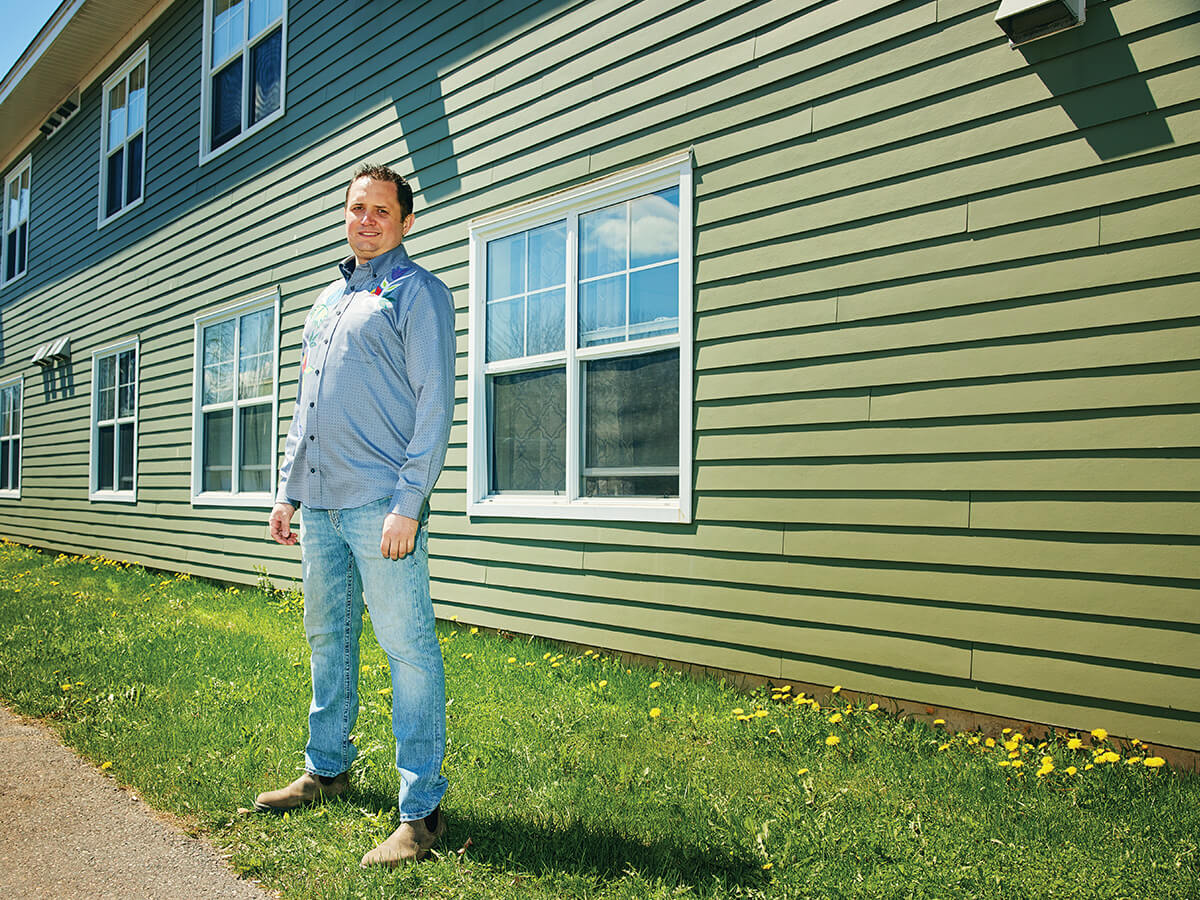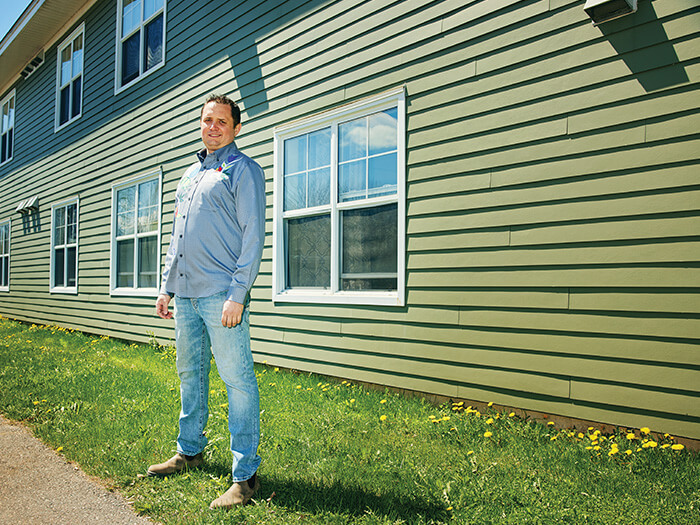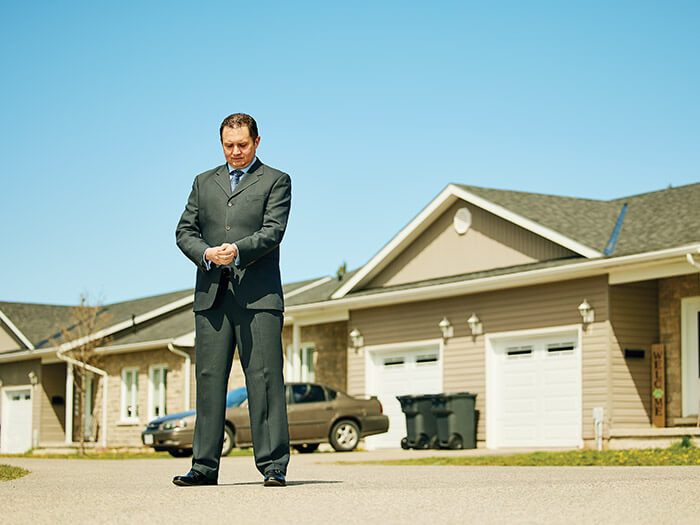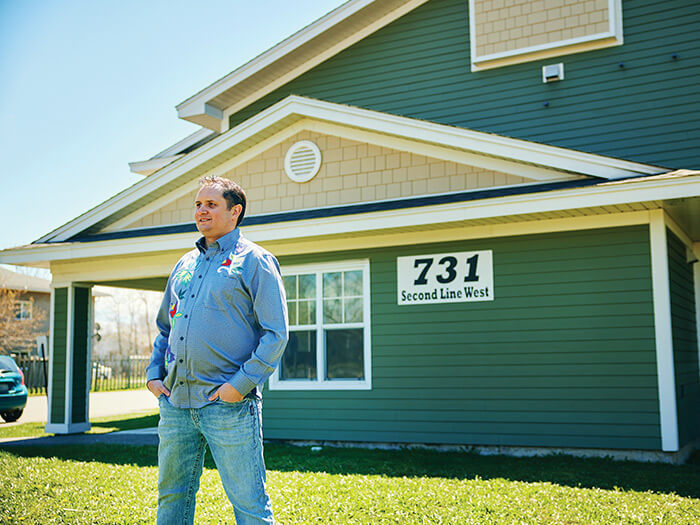
Meet the CPA fighting for Indigenous housing
 CPA Justin Marchand, who identifies as Métis with Algonquin and Mi’kmaq ancestry, has become an unrelenting champion for Indigenous housing (Photograph by Daniel Ehrenworth)
CPA Justin Marchand, who identifies as Métis with Algonquin and Mi’kmaq ancestry, has become an unrelenting champion for Indigenous housing (Photograph by Daniel Ehrenworth)
The small town of Sioux Lookout, Ont., sits halfway between Thunder Bay and Winnipeg, enveloped by picturesque lakes, dense forest and the Canadian Shield. It’s home to roughly 5,000 people and the Sioux Lookout Airport, a hub for travellers flying between southern cities and remote northern communities.
In late 2015, as temperatures crept below freezing, a chief from a First Nations community asked the town’s mayor, Doug Lawrance, whether he could house two of its members who had moved to Sioux Lookout but had nowhere to stay. Lawrance called a handful of local housing agencies, but none had room; they were already struggling to find beds for dozens of people, most of them Indigenous. “There were just no solutions,” Lawrance said at the time. So he wrote to the provincial ministry responsible for housing, pleading for help. “The need is incredible.”
Sioux Lookout is a microcosm of the housing crisis facing Indigenous people across the country. Adequate housing is essential for stability, and yet, despite accounting for only 4.9 per cent of the population, Indigenous people are disproportionately represented among Canada’s unhoused, and they’re more likely to live in precarious housing. Inadequate housing is often at the root of their over-representation in foster care and prison, and housing is mentioned nearly 300 times in the final report prepared by the National Inquiry Into Missing and Murdered Indigenous Women. Indigenous people are also more likely to be unemployed; it’s difficult to find a job when you live in your car. “If you don’t have your foundational needs met—one of them being shelter—nothing else can really thrive,” says Margaret Pfoh, CEO of the Aboriginal Housing Management Association, an umbrella organization of Indigenous housing and service providers in B.C. “Without housing, how can we focus on education, on health, on reuniting families?”
In response to Lawrance’s letter and similar requests for help from the social housing agency in the area, Justin Marchand flew to Sioux Lookout in 2016. At the time, Marchand, a CPA, was the director of operations for Ontario Aboriginal Housing Services (OAHS), a non-profit based in Sault Ste. Marie, Ont., that provides shelter, affordable rentals, home-ownership programs and support services to both Indigenous and non-Indigenous people. It’s Ontario’s largest Indigenous housing provider. “If somebody comes through the door and needs help, we help them,” he says.
Marchand, who identifies as Métis with Algonquin and Mi’kmaq ancestry, is 41, with short dark hair and a relaxed grin. He arrived in Sioux Lookout accompanied by his boss, Don McBain, who’d founded OAHS in 1994 and was revered for his unwavering dedication to Indigenous housing. They intended to develop and build a permanent, 20-unit supportive housing complex that could help people get off the street and transition into stable housing.
It was no simple task. McBain and Marchand spent months tirelessly brokering agreements among the municipality, the district services board, and the provincial and federal governments. Blowback from the local communities only made the job harder. Incidents involving Sioux Lookout’s unhoused—violence, disturbances, overdoses—were taxing the town’s police, paramedics and hospitals, and some locals opposed the idea of spending more tax dollars on Indigenous support.
“There was a bit of hesitation, to put it politely, about us building housing for those people,” says Marchand. But to him, the project was simply the right thing to do, both morally and financially. “Do we want to spend more than $180,000 a year housing someone [in prison] who’s not supposed to be there, with no support once they leave? Or should we be proactive and spend less than 10 per cent of that on housing so they don’t end up in jail?”
 Marchand at an OAHS housing development in Sault Ste. Marie, Ont. (Photograph by Daniel Ehrenworth)
Marchand at an OAHS housing development in Sault Ste. Marie, Ont. (Photograph by Daniel Ehrenworth)
In September 2017, shovels hit ground. It should have been cause for celebration but, that same week, tragedy struck. After a brief battle with cancer, Don McBain died. He was 58. “Everyone was caught off guard,” says Marchand, who used to joke that McBain would never retire. “He always said he was going to be working three weeks after he died, from the other side.”
Still grieving his friend and mentor, Marchand stepped into McBain’s shoes. As OAHS’s new executive director, he inherited not just the Sioux Lookout development, but many others like it. “I can’t overstate how difficult a time that was,” he says. His phone rang constantly; his email inbox overflowed. He lost sleep, working nights and weekends. The organization was overwhelmed and underfunded. It manages 2,400 units across the province and is developing thousands more to keep up with demand. As of June, OAHS had 6,000 housing applications on their waitlist. The backlog of requests for repairs and renovations is even longer. “We just can’t meet the need,” says Marchand. “We have the systems . . . and I know we could ramp up quickly if the resources were behind us.”
Over the last few years, Marchand has been fighting for those resources, meeting with federal and provincial lawmakers and lobbying for equitable policy. In the mould of his late boss, he has become an unrelenting champion for Indigenous housing. He sees his work as a way to begin healing the damage done by colonization, residential schools and the Sixties Scoop—all of which inflicted trauma that has passed down through generations of Indigenous people. “We’ve been told we need to get onto a path of reconciliation,” he says. “It’s time to start taking the first steps.”
Marchand never intended to work in housing. He just knew he wanted to help people.
Under Marchand’s leadership, OAHS is bigger and better funded than ever. It has 110 employees, compared to 38 when he started, and he managed to negotiate a funding increase when the province was slashing nearly everything else. Still, Marchand is quick to deflect credit. “A lot of the things we’ve accomplished in the last three and a half years, they are still things that Don had his fingers on,” he says. Once, a few minutes after we finished speaking about the organization’s growth, he emailed me: “Everything we do here is a team effort . . . just wanted to make sure that’s clear.”
Emily Sayers, a CPA student and financial analyst for OAHS, told me that Marchand’s passion for Indigenous housing is infectious and inspiring. “Justin reminds us why we’re here and that the work we’re doing is so important,” she says. “I may not ever see the person who lives in one of our homes, but I’m still contributing to the whole picture. He reminds us of that all the time.”
Marchand never intended to work in housing. In fact, growing up in and around Sault Ste. Marie, where he lives now, he didn’t know exactly what he wanted to do—just that he wanted to help people. He was good with numbers, so he studied commerce and accounting at the University of Ottawa before pursuing his professional accounting designation. “I didn’t have a set career path in mind, but I knew that when the right thing came along, the accounting education and training was going to be so helpful,” he says. “I can’t say enough about the business perspective it provided.”
Throughout the 2000s, Marchand worked as a staff accountant for KPMG, an analyst for Algoma Steel and an audit specialist at the Ontario Lottery and Gaming Corporation. In 2009, Marchand saw an opening at OAHS, which piqued his interest. “I’d always wanted to use my appreciation for numbers for the greater good,” he says. Once on the job, “I fell in love with the organization, its mission and its vision.”
Now executive director, he says his CPA training helps him measure the outcomes of the housing OAHS provides, such as savings in law enforcement and health care costs. “If you can shine a light on that data, all of a sudden you get these strange alliances between property taxpayers, business owners and a non-profit Indigenous housing organization,” he says.
Working in housing can be dispiriting—there are always more heads than beds. But, when Marchand assumed the top job at OAHS in 2017, he and other Indigenous housing leaders had reason to be hopeful. The federal government had promised it would develop a housing strategy specifically tailored to the Indigenous people who don’t live on reserve, the demographic served by OAHS and other agencies like it. But, that November, when the federal government announced the National Housing Strategy—a multi-billion-dollar plan intended to ensure every Canadian has a safe, affordable place to live—there was no sign of the promised legislation vis-à-vis Indigenous housing.
“We all felt blindsided,” says Marchand. In a statement, a spokesperson for Canada Mortgage and Housing Corporation said, “There remains a strong need for an urban, rural and northern Indigenous housing strategy to fill critical gaps.”
In the months following the announcement, Marchand conferred with members of the Canadian Housing and Renewal Association’s Indigenous Caucus, a body that acts as a unified voice for Indigenous housing providers nationwide. If the government wouldn’t develop policy that included them, they would create their own.
 Marchand continues to push for a national Indigenous housing strategy (Photograph by Daniel Ehrenworth)
Marchand continues to push for a national Indigenous housing strategy (Photograph by Daniel Ehrenworth)
In 2018, Marchand and the rest of the caucus proposed a “for Indigenous, by Indigenous” housing strategy, arguing that they, not government, were in the best position to provide housing and related services to Indigenous communities. “It’s more than just putting a roof over somebody’s head. It’s understanding that a lot of our people, in their reconnecting to their roots, are implementing a lifestyle unique to Indigenous peoples, whether that’s fishing, hunting or intergenerational family structures,” says Pfoh, a member of the caucus. “We understand what we need to help our communities survive and thrive, because we’ve been doing it for 50 years.”
The cornerstone of the caucus’s proposal is the creation of an Indigenous housing centre, a national body designed, owned and operated by Indigenous people. The centre would manage all funding and data for new Indigenous housing initiatives and provide low-interest loans and grants aimed at eliminating the gap between Indigenous and non-Indigenous people’s housing needs. The strategy would formally give Indigenous people self-determination over their own social housing, something the federal government has never granted. “There was a time when government would say, ‘We’re not letting Indigenous people take this money; we’re going to keep our foot on their neck, watch every penny and scrutinize everything they do,’ ” says Kevin Albers, a CPA and the CEO of the M’akola Housing Society, an agency in B.C.
Earlier this year, it looked like that might finally change. In February, the House of Commons Standing Committee on Finance recommended that the 2021 federal budget include the creation of a “for Indigenous, by Indigenous” housing strategy, the very thing the caucus had proposed. “Government is finally demonstrating faith in the Indigenous community to be the solution for its own people,” Albers, also a member of the caucus, said at the time.
When the budget was unveiled, however, the Indigenous housing strategy was once again absent. “Huge, huge disappointment doesn’t even begin to describe that miss,” says Marchand. He doesn’t interpret the decision as a defeat, just a delay. “We aren’t letting down.”
In April, Marchand was elected chair of the Indigenous Caucus. In this role, he’ll be leading the charge for an Indigenous housing strategy. He is characteristically deferential about his new position, insisting that the caucus is and will continue to be a group effort. “Justin is a leader among leaders,” says Albers. “We have complete confidence in him to help us get across the finish line.”
A federal Indigenous housing policy may take years to develop and finalize in government. Thanks to the pandemic, however, the need is more urgent than ever. Housing experts say that more people are on the streets than ever before, avoiding shelters out of fear of infection (in Toronto alone, more than 1,000 COVID-19 cases have been linked to outbreaks in shelters). Many others have lost their jobs and are now at risk of losing their apartments or houses. “We’re worried about the wave of coming evictions—the people who worked in restaurants and other low- to middle-income jobs,” says Marchand. He estimates Ontario’s Indigenous population will need another 22,000 safe, affordable homes in the coming years, which will cost billions to build.
The supportive housing that OAHS developed in Sioux Lookout has made a small but meaningful dent in that need. When it opened its doors in 2018, staff matched the new residents with caseworkers, taught them money management and job training skills, and provided addiction and mental health supports to those who needed them. Within six months, the number of 9-1-1 calls in Sioux Lookout—which had mostly concerned the same two dozen unhoused individuals—dropped by 90 per cent, and the town began saving hundreds of thousands of taxpayer dollars per year. “Now we’ve got the local property-owner tax base thrilled that we’re saving them all kinds of money,” says Marchand. “They want us to build more housing.”
The benefits for the residents go beyond dollars and cents. Some of them have since moved into stable housing, on their way to escaping the cycle of poverty. “People may not understand, we didn’t choose to be homeless,” one resident said. “Just having the security of knowing I can come to my home . . . It’s a relief to have. It’s a blessing.”
FOCUS ON INDIGENOUS COMMUNITIES
Better understand the perspective of Indigenous students as they navigate through the CPA profession with CPA Canada’s Introduction to Indigenous People culture course.
Also, earn how Indigenous communities are regaining economic independence, how a determined group of entrepreneurs is opening up the north for business and how former prime minister Paul Martin’s charity is improving education, health and well-being outcomes for Indigenous children and youth in Canada.